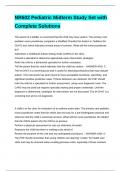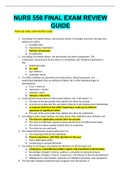Exam (elaborations)
NR602 Pediatric Midterm Study Set with Complete Solutions
- Course
- Institution
NR602 Pediatric Midterm Study Set with Complete SolutionsNR602 Pediatric Midterm Study Set with Complete SolutionsNR602 Pediatric Midterm Study Set with Complete SolutionsNR602 Pediatric Midterm Study Set with Complete SolutionsThe parent of a toddler is concerned that the child may have autism. Th...
[Show more]




